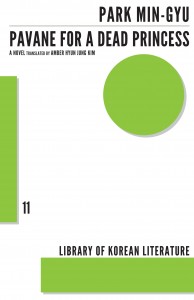 A version of this review was first published in Acta Korean in December 2014, with a companion review of Choe In-hun’s The Square by Barry Welsh. The entire volume is worth checking out.^^
A version of this review was first published in Acta Korean in December 2014, with a companion review of Choe In-hun’s The Square by Barry Welsh. The entire volume is worth checking out.^^
Pavane for a Dead Princess takes Park Min-gyu’s swift literary punching power, clever dialogue, and loathing of modernity, and gives us a slowly but inevitably moving love story of the son of a movie-star and his ugly girlfriend (the narrator describes her as “the world’s ugliest woman), often accompanied by their mutual friend, Yohan. Particularly, Park uses the extremely superficial nature of societies’ reaction to the affair, as a position from which to assess Korean/modern values, values he finds lacking humanity. The book is published as part of an ongoing partnership between the Literature Translation Institute of Korea and Dalkey Archive Publishing.
Pavane’s elevator pitch might be; “boy meets ugly girl; boy falls in love; girl stays ugly; boy stays in love.” Certainly, no movie of this book will ever be made – a point Park drives home directly: in the book, a script describing the love affair is rejected with the unanimous opinion that a woman can overcome any hurdle except for being permanently ugly. The scene is funny and horrible at the same time.
Park’s narrator is a 35 year-old semi-autobiographical author who is attempting to re-establish connection with that “ugly” girlfriend he lost through an unfortunate occurrence, the occurrence which starts off the novel.
As the book opens the young boy meets his ugly girlfriend in a snowfall (snow being one of Park’s many recurring motifs) “for the last time,” and then flashes back one year to explain the path to that “last” meeting, beginning with their first meeting from which the apparently mismatched teens tenuously begin to fall in love.
This developing love is the plot Park builds over the theme of the emptiness of society. Park, attacks society violently, but suggests that there may be a way to, if not to defeat a society dedicated to superficiality, than perhaps live parallel to or in disregard of it, and that the power of this lifestyle is based on relationship and/or love, not economy. This is parallel to arguments he has made in previous works, including Is That So? I’m a Giraffe and Dinner with Buffett.
Park is sparklingly imaginative: In one memorable image an important third character, imagines the ruckus that uneven rectum wrinkling would cause in a world where everyone looked beautiful; work scenes portray the repetition, strain, and boredom work creates; Park’s treatment of mis-spelled signs in a bar is a series of clever scenes and an authorial act of symbolic clairvoyance; an overcrowded amusement park is used a metaphor for how people treat life; oh, we came here, there’s a line, we’d better try it.
Then, however, pivoting quickly, Park diverts that idea into a specific love scene of considerable power. Park is surprisingly gentle with his characters as individuals at the same time he guts society as a whole.
Special note must be made of Yohan, the character who completes the triad of friends – a master of the extended, seemingly bizarre, arguments that once fully-fleshed, becomes surprisingly descriptive and useful. It is Yohan who, amidst the developing love story (which he helps develop) presents many potentially boring social arguments (often while reaching for or drinking a beer) related to beauty, money, success, and social appearance, yet for much of the novel keeps the tone light.
As the conclusion draws near Park has one last authorial trick up his sleeve, a modernist multi-perspective tactic that suggests that living a relationship-based and not achievement/cash-based life is not impossible, nor does it require the strength of any particular love or relationship – just love and/or relationships.
Pavane for a Dead Princess is stylistically in line with Park’s previous works: it is written in clear, blunt-instrument sentences that not only land on their mark but always leave marks. Park uses short, blunt-instrument sentences, but not to elide emotion, rather to create something like a latticework out emotion from them. Each sentence contains its bit of truth, its symbol, a narrative role, and then settles in and lets the next sentence do its work.
Pavane for a Dead Princess, can simply be read as a love story; a love triad really, and it’s arc(s). It can also be read as an attack on how the first world has aestheticized money, while at the same time reducing aesthetics to money. With a clever plot, some interesting questions about industrial/post-industrial capitalism, and a love story rolled into one, Pavane for a Dead Princess is an excellent first novel for a reader looking for a translation that portrays modern Korean culture (though in this case pretty regularly in negative terms). It is also a good read, and that is reason enough to recommend it.


